Caitlin Doughty's Blog, page 4
July 11, 2022
The Man Who Took Down a $3 Billion Funeral Empire
April 25, 2022
Why JFK’s Casket Stayed Closed
April 1, 2022
This is How You Died
Hey, this is me, your doctor. You died.
Let’s get this out of the way: there are a couple people in this auditorium who I probably killed.
I wasn’t trying to, of course, but we’ll get to that.
You were not the first people in my care who died, of course. Death comes with my job. People don’t come to the hospital because everything is going super great and they’re having a fun time. They’re sick, many are elderly, and many have been in the hospital seven times in the last six months.
But you are the ones who haunt me when I try to sleep at night.

Every culture has a different idea of what constitutes a good death. Some people want to die in battle. Some people want to die as martyrs. In our culture, we want to die from old age. We want to die in bed, in our sleep. If we can’t have that death, we want to die in a hospital bed with clean white sheets, surrounded by family and sympathetic doctors and nurses. We want them to mourn us and celebrate us as we pass into the dark.
In contrast, the ideas about what constitutes a bad death are a little more unified across cultures. A bad death is an unanticipated death or an excruciating death. We fear, worst of all, that we will die alone — and that no one will know what happened to us.
You died the worst kind of death, and for all of my training, all of my sophistication and artistry, I was powerless to stop it.
You died gasping.
When I talk about suffering to patients and their families, I contextualize it as “the four horsemen.” The four horsemen of suffering are pain, itch, nausea, and breathlessness. All four of these can become such an excruciating torment that they can they rob us of our wits, that they can cause people to beg for relief — but for the first three, for pain, itch and nausea, eventually, even if relief isn’t possible, people curl up, they withdraw into themselves, and they shut down.
But with breathlessness, we stay awake. We fight until our very last gasp.
Covid-19 causes acute respiratory distress syndrome, a form of pneumonia so severe I had only seen it two or three times. Then, in April 2020, every single bed in my hospital was full of Covid patients. Many had ARDS.

Those who don’t die from the pneumonia die from the blood clots, which can block the vessels of the lungs instantly, preventing gas exchange.
Worst of all, though: you died alone.
Because we didn’t have enough personal protective equipment, we often just left you alone with the sedation drips and the ventilator running when we knew you were dying. We had to go save other people, people who had only been on the vent a few days, people we thought might have made it.
Look at the two people sitting beside you.
One of those people, I abandoned to die alone.
One of those people is the person I abandoned them for. That’s the person I tried to save, who I tried to save desperately, who I gave more resources and time than calculating clinical logic should have allowed.
Maybe one of those people is one where I had an impossible choice — a choice between bad and worse — and I still managed to choose wrong.
One of you was in kidney failure due to profound dehydration. When I gave you IV fluids to try to preserve your kidney function, even though it was the smallest order for fluids I’d written in my career, it was still enough to flood your damaged lungs. After that, all I could do was give you a little morphine to take the edge off while you drowned.
One of you got so confused that you pulled off your mask. You pulled it so hard it broke something behind the wall. I knew how to get the mask back on, I knew how to troubleshoot the BiPAP machine, but by the time I realized that the problem was in the wall, by the time I yelled for someone to get a portable oxygen tank…. You couldn’t speak, but you were looking into my eyes. You knew I was the doctor who had helped you feel better every other time your breathing got bad. Why wasn’t I helping you this time? You died before they found the oxygen tank.

There are lots of other stories, of course, but we don’t have eternity — well, I don’t, at least. I’m sorry, I’m really sorry. I hope you don’t think I didn’t care, because I always did. I wish at this point that I was one of those people that could hit a button and turn off my “give a fuck” switch but that’s not possible for me. So this little talk, this goodbye, is the next best thing.
You know, looking out at you now, I feel a little peace. I see how serene you are. I see quite a few of you as I never got to see you in life: together again, holding hands. Christ, though — it was hard, it was so hard, to explain to your kids that they were going to lose both Mom and Dad at the same time.
After the third or fourth time, I got better at that conversation. I made it easier on your children. But afterwards, every time, I would have to find a quiet place, and just sob, imagining if it was my Mom and Dad who had to die alone together, in separate ICU beds one room apart.
Your families miss you so much.
They’d plead with me. That’s common, actually. No matter how many times I explain that I’m not in control, that the disease is in control, it’s much easier to pretend that someone has the power to fix it.
But the tools in the ICU, at best, are just a pause button.
I can hit pause.
I can’t rewind.
There are so many of you, I admit, that some of your faces now seem unfamiliar to me. Of all the guilt I carry with me, that’s the worst.
That I lost you once — that’s bad enough.
Then lost you again, when I fucking forgot.
I can already see you looking around the auditorium and then looking back at me like I’m losing my mind. That there are hundreds of you, that I couldn’t have possibly kept all that inside my head without going really and truly insane.
I know our time is almost up.
I can’t pretend this was easy, but it was good. It was good to see you all again. I will say goodbye the way I always said goodbye to your families: it was my honor and privilege to care for you.
That’s how you died.
Now, maybe, I’ll be able to say goodbye for good, and finally get some sleep.
March 15, 2022
Let’s Try an Old Fashioned Ghost Grift
February 24, 2022
5 Essential Reads on African American Deathways and Death Work
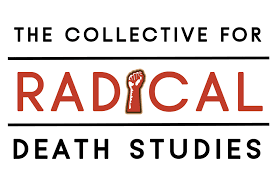
1. Let me strongly suggest the “African/Diasporic Deathways” section of our Radical Death Studies Canon. This list of books, essays, videos, news articles and databases that center African/African American death work and Black mourning, grieving, burial, and death practices for cultural understanding. The scholarship included centers on how the Black experience in death is as much about reacting and surviving racist and white supremacist structures as it is a celebration of Black life.
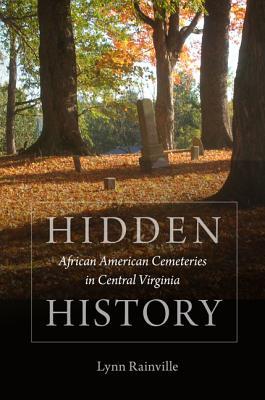
2. In Hidden History: African American Cemeteries in Central Virginia, author Lynn Rainville tells us why slave cemeteries and historic African American cemeteries are so very important to American history. Researching more than 150 cemeteries in Virginia, she carefully describes how these spaces are museums of Black life and culture that frankly may not be preserved anywhere else. In this primer, complete with a how-to grave-marker form, Rainville masterfully illustrates how and why Black cemeteries are so important to family genealogy and our nation’s understanding of its racialized urban landscape.
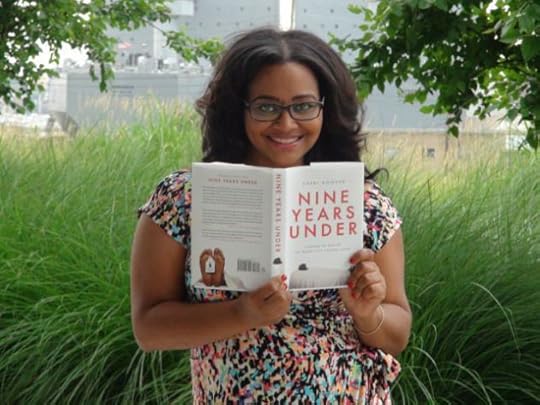
3. In Nine Years Under: Coming of Age in an Inner-City Funeral Home, author and funeral director, Sherri Booker does an amazing job capturing the cultural importance of the Black funeral director to their community. In her easy-to-read conversational style writing, she uses her experience in one of Baltimore’s prominent funeral homes to discourage the myth of the big, bad and greedy boogey undertaker that Jessical Mitford has canonized within Death Studies.
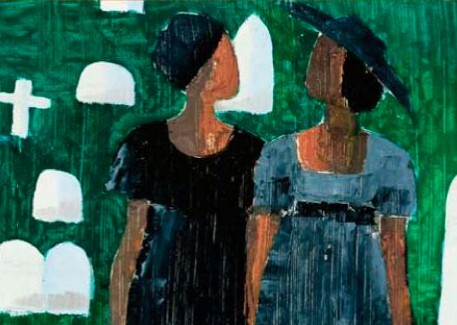
4. Author LeRhonda S. Manigault-Bryant’s book Talking to the Dead: Religion, Music and Lived Memory Among Gullah/Geechee Women is a must read about the importance of Black women as conduits for God because we talk to the dead, which is an ongoing spiritual encounter that consists of dreams, storytelling, and memorialization of loved ones in Gullah/Geechee community.
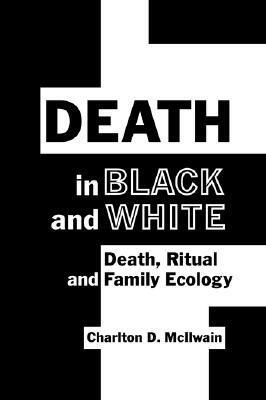
5. After attending several funerals where the decedent was white and several where the decedent was Black, Charlton McIlwain wrote Death in Black and White: Death, Ritual and Family Ecology in which he successfully argues how it is the emotion of Black mourners and the lack thereof by whites that is the separating factor in why the funerals are so different. McIlwain points out this emoting by African Americans as distinctive due to the attachment to the body and our insistence on proper care and respect and whites being socialized to discourage verbalized public grieving.
February 17, 2022
Is This $250 Million Selfie Spot Dangerous?
January 22, 2022
Were Books Really Bound In Human Skin?
December 17, 2021
The Luo Dirge That Ushers The Dead To Immortality
“A woman’s final home is immortality.”
I first heard this phrase at my aunt’s funeral when I was eleven years old. As she approached our homestead in Kisumu, Kenya, a woman started singing with passionate tremolo while slow-dancing to the rhythm of her song. She scooped dust from the ground, showered it over her head, and finished by chanting the words of the dirge she had composed for my aunt, “Achopo ka osiep agoga. Jaber thurgi cho, nyakwar Oyuko min rwathe. Chunye ler ka pi soko. Tho iseloyo, tho ogol! iseloyo! iseloyo!” (“I’m here, my bosom friend. A woman’s home is immortality, granddaughter of Oyuko, mother of eminent men. Your heart is pure as water from a spring. You have conquered death, dying be damned! You have won! You have won!”)

Luo men going to a funeral, 1929. Photo courtesy Mclecki.
She was performing the Luo mourning elegy, called Sigweya. Declamatory recitations in which somber words are chanted in free rhythm, but with great emotion.
Over the years, I’ve attended many funerals and witnessed various Sigweya performances, but their message remains the same, each one extolling the virtues (real and imagined) of the deceased, and perpetuating the continuity of life beyond the natural mortality of the flesh. That’s why my aunt’s friend addressed her directly in the dirge as though she was there in person. Death did not end my aunt’s existence; she continues to live, and was present at her funeral, witnessing all the happenings.
My people, the Luo of Kenya, believe that life begins in immortality and ends in immortality. This cycle starts at tipo (spirit) to ringre (body) and back to tipo (spirit) Therefore, death is merely a rite of passage, an opening to another life. When one dies, the only variation is that the body perishes, while the spirit lives on, retaining the individual’s identity. In his book African Religions and Philosophy, Professor Mbiti aptly captured the Luo belief when he wrote, “Death is conceived as a departure and not a complete annihilation of a person. The only major change is the decay of the physical body, but the spirit continues to live within the community.”
Sometimes our dead come back in the flesh. A spirit desirous of a physical frame will ask to be named by appearing through a vision, or there would be a situation where a newborn cries continuously and the household then calls out names of their departed kin until they hit the right one. They know this when the infant ceases to cry. When a child is given a spirit name (nying juok) they assume the identity of the deceased relative. It’s a common thing in the Luo community to hear a man introduce his daughter as mae dana (this is my grandmother) or a baby being referred to as wuonwa (our father). My little sister’s spirit name is nyatiegari, and whenever we travel upcountry for the holidays, she’s the first to be served food, and is usually taken around the farm to bless the crops, while other older members of the family urge her to spit in their hands as a sign of good luck since ‘she is our great grandmother.’
But not all our dead desire physical bodies. Most are content to live as spirits. However, they will return from time to time to share meals with us, or, as Jude Ongong‘a writes in The River-Lake Luo Phenomenon of Death: Rites of Passage in Contemporary Africa, they may occasionally come in the evenings to warm themselves in the company of family. Thus, the Luo say, ng’amaotho ok kuodhi (you don’t gossip about a dead person) because for all you know, they might be sitting beside you listening as you dish their dirt.
Because of this belief in immortality, mourners will perform Sigweya at a funeral to console the bereaved but most importantly, to reiterate that the loss is not total since there is continuity of life. A Sigweya cannot performed by anyone, but only by those who had close ties to the deceased. The Sigweya, unaccompanied by instruments, is usually performed in a lofty style, with each narrator crafting unique personal motifs in their solo performances. The melody of the words being chanted reflects the speech contours of the performer as they move to the rhythm of the dirge.
In a dense, somber mood the mourner, through individual artistry, sings the familiar scenes of the time they shared with the dead, extols their virtues, and describes the pain they feel; while in the process, recreating their life so those who never knew the deceased have an idea about who they were. The narrator finishes by charging the mourners to welcome the dead to immortality. Here is an audio excerpt of Kenya’s former Prime Minister Raila Odinga performing a Sigweya at Senator Otieno Kajwang’s funeral.
Otieno, son of Akoths’ mother, how men revere you!
My friend, son of Waondo, how Kenya depends on you.
Otieno, son of Akoth’s mother, how men revere you!
My friend, who hails from Mbita, how Kenya trusts you.
Hail the buffalo! ( 5 times)
Hail the headgear! (3 times)
(English Translation)

Raila Odinga moments before performing sigweya. Photograph by Titus Munala.
Chanting ‘hail the buffalo’ charges the mourners to extol and accompany Otieno’s spirit as he takes on the immortal life of a courageous hero (the buffalo) while ‘hail the headgear’ refers to the ceremonial headgear made of colobus monkey skin and ostrich feathers worn by great people to symbolize wisdom and immortality.
When Kenya’s first President, Jomo Kenyatta, died, his former vice, Jaramogi Oginga went to eulogize him at the State House. Flanked by two women, he strode to the place where Jomo lay in state and immediately performed his sigweya. In December 2020, when Kenya’s second President died, Raila Odinga did a Sigweya at his funeral chanting the famous words given to a man who was now a warrior spirit, Jowi! Jowi!
The coronavirus has changed the way we bury our dead. As per the Kenyan government regulations, bodies must be buried within 48-hours of death, and with only close relatives of approximately twenty allowed in attendance.
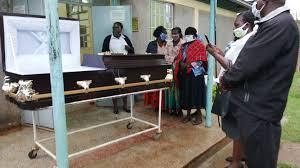
Courtesy BBC/Mercy Juma.
In our culture funerals have always been a community affair, so during this pandemic we have continued to uphold tradition, ensuring that among those few in attendance at the burial ceremonies, Sigweya performers are always present to help usher our departed into honorable immortality; because even death cannot stop our dead from living.
November 19, 2021
November 18, 2021
Marked In Remembrance: How Tattoos Help Us Grieve
Over the past two years many of us have been confronted with the realities of death and grieving. During this time the pandemic has killed hundreds of thousands of people — and is continuing to do so each day. It comes as no surprise that there’s been a surge in memorial tattoos (and tattoos in general) throughout 2021 as shops have reopened.
Tattooers have been doing a booming business, from California to Texas, tattoo artists are very, very busy. In a recent piece from Vox, tattooist Tiffany Garcia noted that more people than ever are coming into her shop in Torrance, California, “It felt like people were trying to find themselves or fulfill a purpose with tattoos,” Garcia told Vox reporter Terry Nguyen. “I’ve had clients say they never thought to get one in their life.
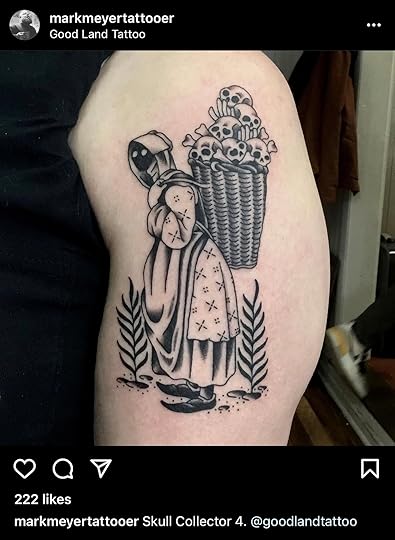
Tattoo art for Brittany Rios by artist Mark Meyer with Goodland Tattoo
Adam Sky opened Morningstar Tattoo in Belmont, California in January 2020. A few weeks later, the pandemic forced the shop to shut down. Now he says he’s booked at least a year out,“I’ve never been this busy in my 25 years of tattooing,” said Sky, “My advice would be to make your tattoo plans well in advance, because everybody is slammed.” People are, Sky said, “living out their tattoo dreams” as restrictions ease.
A search for the hashtag “covidtattoo” on Instagram reveals over 3,200 posts, as of this writing. Most of them are similarly themed: plague doctors, bottles of sanitizer, and masked nurses are all common. People who get these tattoos are literally marking this moment in time on their skin. Funny or serious, they’re a (sometimes literal) declaration of survival.
People are not only marking their survival through the pandemic, but also their losses with memorial tattoos. In some cases people will even get a very small amount of cremains mixed into the ink, allowing them to carry a piece of their loved one with them forever, in much the same way someone else would carry a locket.

In her 2009 Masters thesis for Smith College, Eliza Schiffrin explores the memorial tattoo as a kind of modern mourning ritual. The paper notes that Western society as a whole has largely left behind public grieving rituals connected with death and mourning.
Schiffrin mentions the Jewish tradition of Kriyah (also spelled Kriah), where clothes or a black ribbon worn on someone’s clothing are torn to represent the internal anguish of losing a loved one. The week after a death, called Shiva, is spent remembering the events that led up to the deceased’s death as well as the events of their life. Participants in an Irish wake throw a party in honor of the deceased’s life and get to see that person out of their homes for the final time before they’re buried.
Both rituals provide a framework people can use to deal with the emotions they’re feeling and be supported by members of their community. Schiffrin argues that memorial tattoos can serve a similar purpose to grieving rituals by inviting conversation about the story, and thus the person, behind the art. The tattoo can be an externalization of the wearer’s grief, a physical marker that helps separate it from the person emotionally.
Another practice that started before the pandemic is preserving the tattoos of a loved one after death.
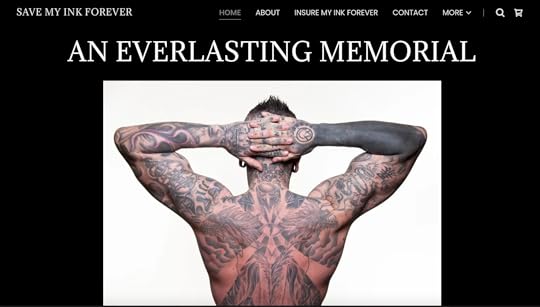
Save My Ink Forever website
Companies like Save My Ink Forever work with funeral homes and crematories, sending them a “recovery kit” with all the required equipment needed to carefully remove and process the tattooed areas of a person’s skin. Once that’s done, the skin is sealed in high-quality glass to protect and preserve the art, then framed. The end result looks something like papyrus, and if someone is open to it can be a valuable keepsake.
Megan Rosenbloom, author of the book Dark Archives: A Librarian’s Investigation into the Science and History of Books Bound in Human Skin, says the practice is something tattooed people might appreciate: “When you talk to tattoo people about ‘would you wanna preserve your tattoos forever…it doesn’t seem to gross them out. They’re like ‘oh yeah, that’d be cool’…I can’t speak for everyone but…If your loved ones you left behind have similar values about it…you’d have something that is very uniquely that person.”
Memorial tattoos seem to occupy a strange middle ground in our societal relationship with the sacred. They’re reminiscent of other traditions that honor dead ancestors, but aren’t part of any one religious practice, and separate from the mainstream Christian ideal of maintaining a supernatural relationship only with god.
Deborah Davidson, a professor of sociology at Ontario’s York University who’s studied memorial tattoos extensively, says her research confirms the idea of these tattoos as a sort of bond with the sacred dead. “As a tangible part of living flesh, tattoos serve as a translator of experience into a language more readable by others – a language comforting to the griever, and less disturbing to others,” she said. “All of my participants in my memorial tattoo research expressed the specific detail that they felt the deceased were still ‘with them.’”
Davidson’s interest in memorial tattoos started in 2009. While volunteering with the nonprofit Bereaved Families of Ontario, she met a woman with a tattoo memorializing the daughter they lost to suicide. Davidson set out to find more people with this type of ink, eventually starting her website The Tattoo Project dedicated to her findings, which later became a book. The work caused Davidson to reevaluate her opinions on tattoos, and she’s gotten several of her own since starting the project.
She identified five main reasons why people get memorial tattoos, from enduring physical bond with the deceased to facilitator of conversation. “We live in a culture where grief is still a taboo subject and…a difficult dialogue,” says Davidson. “Talking about one’s tattoo becomes a method to maintain a memory of someone in our external environment but also to introduce this person to new acquaintances by bringing knowledge of their existence into our new relationships.”

Whether they lost someone to COVID or not, people getting tattooed now seem to have a desire to mark the dark stretch of time we’ve lived through in some way. We want to point to a box on the calendar or a design on our skin and say “That’s when it ended. That’s when it started to get better.”
Memento mori can also be translated from its original Latin as, “remember that you must die.” Objects that symbolize death, like skulls or dead flowers, can be memento mori. They remind us to wake up and live, because we’ve only got so many minutes, and in the case of a memorial tattoo, they can remind us what we’ve survived, and who we’re carrying on for.
Caitlin Doughty's Blog
- Caitlin Doughty's profile
- 8407 followers



